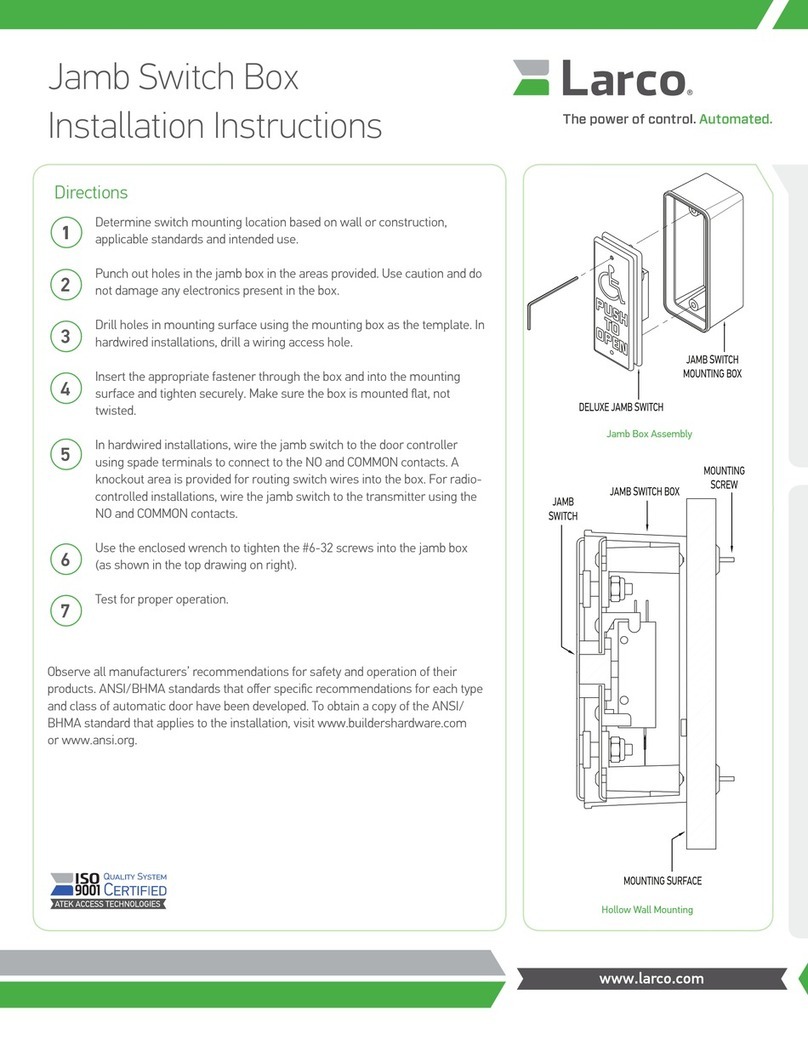
USER GUIDE>AUTOMATIC DOOR PRODUCTS
LARCO 1902 13th Street, Brainerd, MN 56401
PHONE 800.523.6996 FAX 800.589.3705 WEB www.larcomfg.com
PS 333, OCT 2007 PAGE 2
INSTALLATION & MOUNTING INSTRUCTIONS (cont.)
SETTING THE SENSING FIELD AND HOLDING TIME
TROUBLE SHOOTING
7. Use a screwdriver to pry the
cover frame from the sensor
switch.
8. Power up the sensor and check
whether the LED lights up.
9. Check the sensitivity and repeat
setp 5 if necessary.
10. Push the sensor swtich into the
box and screw the sensor tight.
11. Push the cover frame back onto
the sensor to secure.
LED
APPLICABLE ONLY FOR ‘SENSE’ MODE
HOLDING TIME SENSING FIELD
PT2 PT2
PT1 PT1
0.5 sec 10 sec
MIN. MAX.
SYMPTOM CORRECTIVE ACTION
LED does not light up or blink (upon being
powered up).
1. Check if the cable is screwed tight.
2. Check whether the supply is switched ‘ON.’
Door does not open. 1. Check if LED is switched ON.
2. Check the sensor’s connection.
3. Check the sensor Output (relay NC/NO)
connections.
Door remains permanently open. 1. Check Holding Time (PT2).
2. Check for surrounding disturbance.
3. Reduce the Sensitivity level (PT1)
4. Check if it is in ‘Switch’ mode.
FCC ID: RQL336806
This device complies with part 15 of the FCC Rules. Operation is subject to the following two
conditions: (1) This device may not cause harmful interference, and (2) this device must ac-
cept any interference received, including interference that may cause undesired operation.
Note: This equipment has been tested and found to comply with the limits for a Class B
device, pursuant to part 15 of the FCC Rules. These limits are designed to provide reasonable
protection against harmful interference in a residential installation. This equipment generates,
uses and can radiate radio frequency energy and, if not installed and used in accordance with
the instructions, may cause harmful interference to radio communications. However, there
is no guarantee that interference will not occur in a particular installation. If this equipment
does cause harmful interference to radio or television reception, which can be determined by
turning the equipment off and on, the user is encouraged to try to correct the interference by
one or more of the following measures:
-Reorient or relocate the receiving antenna.
-Increase the separation between the equipment and receiver.
-Connect the equipment into an outlet on a circuit different from that to which the receiver
is connected.
-Consult the dealer or an experienced radio/TV technician for help.
The user is cautioned that changes and modifications made to the equipment without the
approval of the manufacturer could void the users authority to operate this equipment.




















